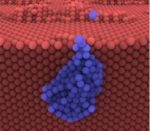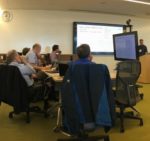“NERSC is a member of the COVID-19 High Performance Computing Consortium. In support of the Consortium, NERSC has reserved a portion of its Director’s Discretionary Reserve time on Cori, a Cray XC40 supercomputer, to support COVID-19 research efforts. The GPU partition on Cori was installed to help prepare applications for the arrival of Perlmutter, NERSC’s next-generation system that is scheduled to begin arriving later this year and will rely on GPUs for much of its computational power.”
Epic HPC Road Trip stops at NERSC for a look at Big Network and Storage Challenges
In this special guest feature, Dan Olds from OrionX continues his Epic HPC Road Trip series with a stop at NERSC. “NERSC is unusual in that they receive more data than they send out. Client agencies process their raw data on NERSC systems and then export the results to their own organizations. This puts a lot of pressure on storage and network I/O, making them top priority at NERSC.”
NERSC Unveils Mural for pending Perlmutter Supercomputer
NERSC has unveiled the mural that will grace the cabinets of the Perlmutter supercomputer that will be installed at Berkeley Lab in 2020. “The mural pays tribute to the system’s namesake, Nobel Laureate Saul Perlmutter. The Berkeley Lab physicist led the team whose work at NERSC contributed to the Nobel prize-winning insight that the universe’s expansion is speeding up. The resulting efforts to explain this acceleration led to today’s model of a universe dominated by dark energy and dark matter.”
Podcast: ECP Team Achieves Huge Performance Gain on Materials Simulation Code
The Exascale Atomistics for Accuracy, Length, and Time (EXAALT) project within the US Department of Energy’s Exascale Computing Project (ECP) has made a big step forward by delivering a five-fold performance advance in addressing its fusion energy materials simulations challenge problem. “Summit is at roughly 200 petaflops, so by the time we go to the exascale, we should have another factor of five. That starts to be a transformative kind of change in our ability to do the science on these machines.”
ISC 2019 Recap from Glenn Lockwood
In this special guest feature, Glenn Lockwood from NERSC shares his impressions of ISC 2019 from an I/O perspective. “I was fortunate enough to attend the ISC HPC conference this year, and it was a delightful experience from which I learned quite a lot. For the benefit of anyone interested in what they have missed, I took the opportunity on the eleven-hour flight from Frankfurt to compile my notes and thoughts over the week.”
GPU Hackathon gears up for Future Perlmutter Supercomputer
NERSC recently hosted its first user hackathon to begin preparing key codes for the next-generation architecture of the Perlmutter system. Over four days, experts from NERSC, Cray, and NVIDIA worked with application code teams to help them gain new understanding of the performance characteristics of their applications and optimize their codes for the GPU processors in Perlmutter. “By starting this process early, the code teams will be well prepared for running on GPUs when NERSC deploys the Perlmutter system in 2020.”
NERSC taps NVIDIA compiler team for Perlmutter Supercomputer
NERSC has signed a contract with NVIDIA to enhance GPU compiler capabilities for Berkeley Lab’s next-generation Perlmutter supercomputer. “We are excited to work with NVIDIA to enable OpenMP GPU computing using their PGI compilers,” said Nick Wright, the Perlmutter chief architect. “Many NERSC users are already successfully using the OpenMP API to target the manycore architecture of the NERSC Cori supercomputer. This project provides a continuation of our support of OpenMP and offers an attractive method to use the GPUs in the Perlmutter supercomputer. We are confident that our investment in OpenMP will help NERSC users meet their application performance portability goals.”
NERSC Hosts GPU Hackathon in Preparation for Perlmutter Supercomputer
NERSC recently hosted a successful GPU Hackathon event in preparation for their next-generation Perlmutter supercomputer. Perlmutter, a pre-exascale Cray Shasta system slated to be delivered in 2020, will feature a number of new hardware and software innovations and is the first supercomputing system designed with both data analysis and simulations in mind. Unlike previous NERSC systems, Perlmutter will use a combination of nodes with only CPUs, as well as nodes featuring both CPUs and GPUs.
GPU-Powered Perlmutter Supercomputer coming to NERSC in 2020
Today NERSC announced plans for Perlmutter, a pre-exascale system to be installed in 2020. With thousands of NVIDIA Tesla GPUs, the system is expected to deliver three times the computational power currently available on the Cori supercomputer at NERSC. “Optimized for science, the supercomputer will support NERSC’s community of more than 7,000 researchers. These scientists rely on high performance computing to build AI models, run complex simulations and perform data analytics. GPUs can speed up all three of these tasks.”











